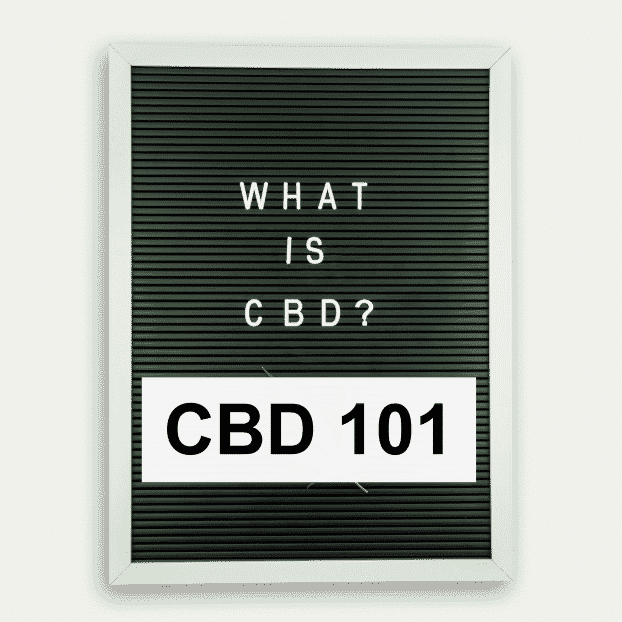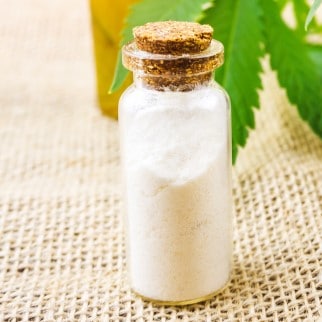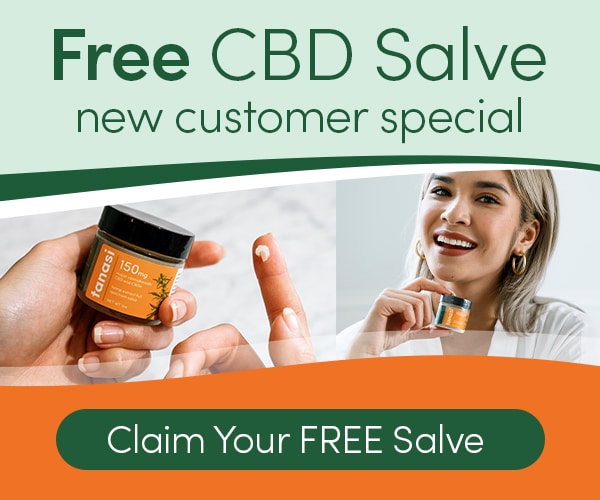CBD 101: A Comprehensive Guide To Understanding CBD

Posted on March 12th, 2021
Cannabinoids recently became a well-known alternative when it comes to pain alleviation and healing with cannabis. They’re a class of chemical compounds extracted from cannabis that interacts with the cannabinoids receptors of your endocannabinoid system. In fact, the benefits of medical marijuana are due to the phenomenon of cannabinoids triggering the receptors in the brain and body. Once the receptors CB1 and CB2 trigger, the ECS starts to restore balance to several of our bodily functions. That’s just CBD 101.
Terpenes and cannabinoids form in the resin glands (trichomes) on the leaves and flowers of the cannabis plant. Cannabinoids and terpenes work together to form a strain’s specific flavor and potency – this phenomenon goes by the name of the entourage effect. Different terpenes and cannabinoids interact to enhance the advantages of the plant’s components. Growers now aspire to breed strains containing high amounts of both compounds because of this.
CBD 101: What Is CBD?
Simply put, CBD is a cannabinoid that naturally exists in the cannabis plant. Scientists currently still research to discover all of the possible therapeutic uses of CBD. Two of the common compounds in marijuana are CBD and delta-9 tetrahydrocannabinol (THC). However, these cannabinoids have different effects.
For a long time, THC was the most popular compound in cannabis. It’s the most active ingredient and causes a psychological effect. It induces a mind-altering “high” once a person smokes it or applies it in cooking. THC breaks down once a person uses heat and proceed to consume it.
In contrast, CBD isn’t psychoactive. It doesn’t alter a user’s state of mind. Nevertheless, it might cause you to experience notable therapeutic effects.
CBD 101: Where Does CBD Come From?
As previously stated, CBD’s source is the cannabis plant. Yet, ‘cannabis’ is just the name of a family of plants from which there are many varieties. Two of the most important ones are marijuana and hemp, which only differ from one another based on THC content. According to the FDA, hemp plants are legal – provided they contain no more than 0.3% THC.
Over time, marijuana growers have carefully bred their plants to have high THC amounts with other compounds they wanted. Nonetheless, hemp growers seldom modify the plant. It is because of its already low THC content that manufacturers use hemp to extract CBD rather than marijuana.
CBD 101: Can You Get CBD From Marijuana?
CBD & THC are in both hemp and marijuana. Marijuana comprises significantly more THC than hemp, whereas hemp contains a lot of CBD but barely any THC. Laws are constantly changing on cannabis. Medical marijuana, with THC, is legal in many states for several uses. However, it remains illegal under U.S. law.
Congress legalized hemp during the enactment of the 2018 Farm Bill. However, there are still rules about how and where you can sell CBD products.
What Is THC?
This is a chemical released by the glands of the marijuana plant. It’s found in large amounts around the reproductive organs and the resin glands of the flower or bud of the female pot plant. THC is only one of 100+ chemical compounds called cannabinoids predominantly found in the cannabis plant. However, it’s the primary psychoactive compound. Thus, It’s the main responsible for causing you to get high whenever you ingest cannabis.
Some people use THC recreational to experience this “high” feeling. Yet, marijuana plants themselves use THC to repel natural predators like bacteria and parasites. Although THC doesn’t have antibacterial effects in humans, CBG, another non-psychoactive cannabinoid found in cannabis, does.
How Is CBD Different From THC?
As you might have deduced, the primary difference between THC and CBD is that CBD doesn’t cause a high – unlike THC. Although THC and CBD share an almost exact molecular mass and molecular formula, the compounds act differently.
THC, marijuana’s psychoactive component, causes you a euphoric high that might impair physical movement and affect memory. CBD will not. Instead, it will deliver therapeutic effects, some of which resemble marijuana’s most positive ones.
Also, when taken before the other, CBD might soften THC effects by reducing stress, anxiety, or other negative feelings. As a result, CBD uses its separate from THC; its purpose goes toward wellness rather than recreational purposes.
CBD 101: How Does CBD Work?
All cannabinoids cause body effects by interacting with CBD receptors. They usually interact with the cannabinoids the body produces on its own, called endocannabinoids. There are two main receptors in the body:
- CB1 Receptors – found all over the body, specifically the brain. They help with appetite, memories, thinking, mood, emotion, pain, movement, etc.
- CB2 Receptors – present in the immune system. Generally, they affect pain and inflammation.
THC usually adheres to CB1 receptors, whereas CBD acts on both receptors differently, ultimately enhancing the effects of the body’s endocannabinoids.
CBD 101: CBD Therapeutic Effects
In general, CBD might possess many possible effects, which is why it became an ideal option for dealing with a range of ailments. However, CBD is still under research; therefore, the information on CBD might change as scientists uncover more about it!
Below are some of the potential CBD therapeutic benefits – supported by early research:
– Reducing Depression and Anxiety
CBD oil might prove to be an effective treatment for people who live with depression and anxiety and are not looking to turn to pharmaceutical drugs. According to several studies, specific CBD doses are very useful at alleviating anxiety before a test.
This doesn’t apply to adults alone. Studies show that CBD oil may safely alleviate insomnia and anxiety in kids experiencing PTSD. Research also hints that CBD can have antidepressant-like effects and might impact how the brain responds to serotonin. Since CBD demonstrated anti-stress effects, it may reduce depression that is associated with stress.
– Alleviating Pain and Inflammation
CBD might be one of the primary reasons marijuana is popular for easing pain. Animal studies have to say that CBD might relieve chronic pain by alleviating inflammation. It might also reduce pain from sciatic nerve pain and surgical incisions. When used with THC, CBD might be beneficial in reducing pain caused by arthritis and multiple sclerosis.
– Helping with Insomnia
Sometimes, people use CBD to help them sleep. Many users report improved sleep after using CBD. Researchers may not yet fully comprehend why CBD may help users sleep better. However, it might be because it can ease stress, depression, and anxiety.
– Reducing Acne
Since CBD decreases inflammation, it might also help reduce acne. Scientists realized that CBD oil might inhibit sebaceous gland cells from secreting too much sebum, the primary cause of acne.
Although we still need more research, CBD might help with other skin problems as well.
– Relieving Chemotherapy-Related Symptoms
CBD might also be beneficial in alleviating some chemotherapy-related pain and other side effects like vomiting and nausea. Studies report a substantial decrease in pain when using CBD and THC combined for this purpose.
– Improving Heart Health
Based on a 2017 study, CBD may even help the heart and entire circulatory system by reducing blood pressure. Ultimately, this prevents health complications such as metabolic syndrome, heart attack, and stroke. It might be because CBD can ease anxiety and stress, which in turn reduces blood pressure. A study on rats also implied that CBD might help alleviate inflammation and cell death linked to heart disease.
– Helping with Neurologic Disorders and Seizures
Although research is still early, CBD might help relieve symptoms associated with Parkinson’s disease, multiple sclerosis, and epilepsy. Several studies discovered decreased seizure activity in kids and young adults after they took CBD oil. Epidiolex is so far the only CBD product that’s FDA-approved to treat two severe seizure conditions.
Other studies say that CBD might improve life quality and sleep quality for individuals with Parkinson’s disease.
Some test-tube and animal studies showed promising early results when it comes to Alzheimer’s disease. CBD might reduce inflammation and prevent the neurodegeneration that comes with the disease.
– Helping with Treatment of Substance Abuse Disorder
CBD may also be effective when it comes to treating substance use disorder. Studies prove that it can alter circuits in the brain associated with drug dependence. A study on rats also demonstrated that CBD could reduce heroin-seeking behavior and morphine dependence.
– Aiding with Schizophrenia
Research also shows that CBD may benefit users with schizophrenia and similar conditions by alleviating psychotic symptoms.
CBD 101: CBD Types
In today’s market, you can generally find CBD in three primary forms. These include full-spectrum, broad-spectrum, and CBD isolate. Read on for a detailed explanation.
Full-spectrum CBD
It typically consists of almost all constituents of the cannabis plant, meaning terpenes, flavonoids, and the other cannabinoids remain. Thus, it has trace THC amounts as well. Full-spectrum CBD products will federally contain less than 0.3% THC.
Broad-spectrum CBD
This CBD type doesn’t contain THC. However, it does consist of other ingredients of the cannabis plant. Therefore, it won’t be 100% CBD only. You can think of it as the middle child of these three CBD options. It’s somewhat weaker than full-spectrum.
CBD Isolate
This is your pure CBD product since it consists of no other compounds existing in cannabis, apart from CBD itself. Despite being only CBD, it gives out the weakest effect out of the three.
CBD 101: CBD Administration Methods
Generally speaking, there are four main methods of taking CBD oil. These include ingestion, topical, sublingual, and inhalation. Below we take an in-depth look at these four methods and some benefits of each. This should help you choose a product better suited for you and your particular preferences.
– Ingestion Options
One of the most popular ways to use CBD oil is by ingesting it orally. Once you ingest CBD orally, it gets absorbed in the digestive system and later metabolized by the liver – this sends its active compounds to the bloodstream. This is the way in which we usually take most vitamins or other daily supplements.
Some of the common ingestible CBD products are edibles, capsules, or CBD oil added to beverages and foods. It’s not uncommon for enthusiasts to infuse CBD oil into some of their favorite meals or even using it as a salad dressing.
– Topical Options
You can massage and rub certain CBD products uniquely made for that purpose. These topical CBD products’ active ingredients are absorbed through the skin. They can interact with cells that are close to the surface and act on them instead of hitting the bloodstream. These are excellent options for people looking to get some localized pain relief or to deal with skin conditions. You can rub them directly in the part of your skin that requires treatment. In today’s market, CBD oil topical products include salves and lotions.
– Sublingual Options
Once you administer CBD oil sublingually, hold it beneath the tongue for about 90 seconds. The mucus membranes in the mouth will absorb that oil’s active ingredients this way. The main reason to use sublingual administration is to bypass the digestive tract and liver metabolization.
Ultimately, this permits the compound to reach the bloodstream and interact with your ECS quicker. For people seeking quick effects, then a sublingual CBD oil it’s a perfect option. CBD oil and tinctures are examples of CBD products made for the sublingual method of administration. You can easily hold them in the mouth to allow absorption of the active ingredients by your mouth’s capillaries before swallowing.
– Inhalation Options
Lastly, you can also inhale CBD by vaporization. Vaporizers usually heat up CBD oil in order to release its active compounds. Through vaporization, CBD can enter the lungs and diffuse directly into the bloodstream. Since the CBD compound will not need to make its way through your digestive system or liver, it enters circulation immediately. Also, you don’t lose significant amounts of CBD through vaporization like you would with liver metabolization. Typically, vaporizing CBD is a consumption method recommended mostly for adults.
CBD 101 – The Takeaway
CBD offers countless potentially therapeutic benefits. Hopefully, this guide educated you on everything you need to know before about the CBD compound.
What are you waiting for? Check out Tanasi’s online shop and find a product that suits your needs.






